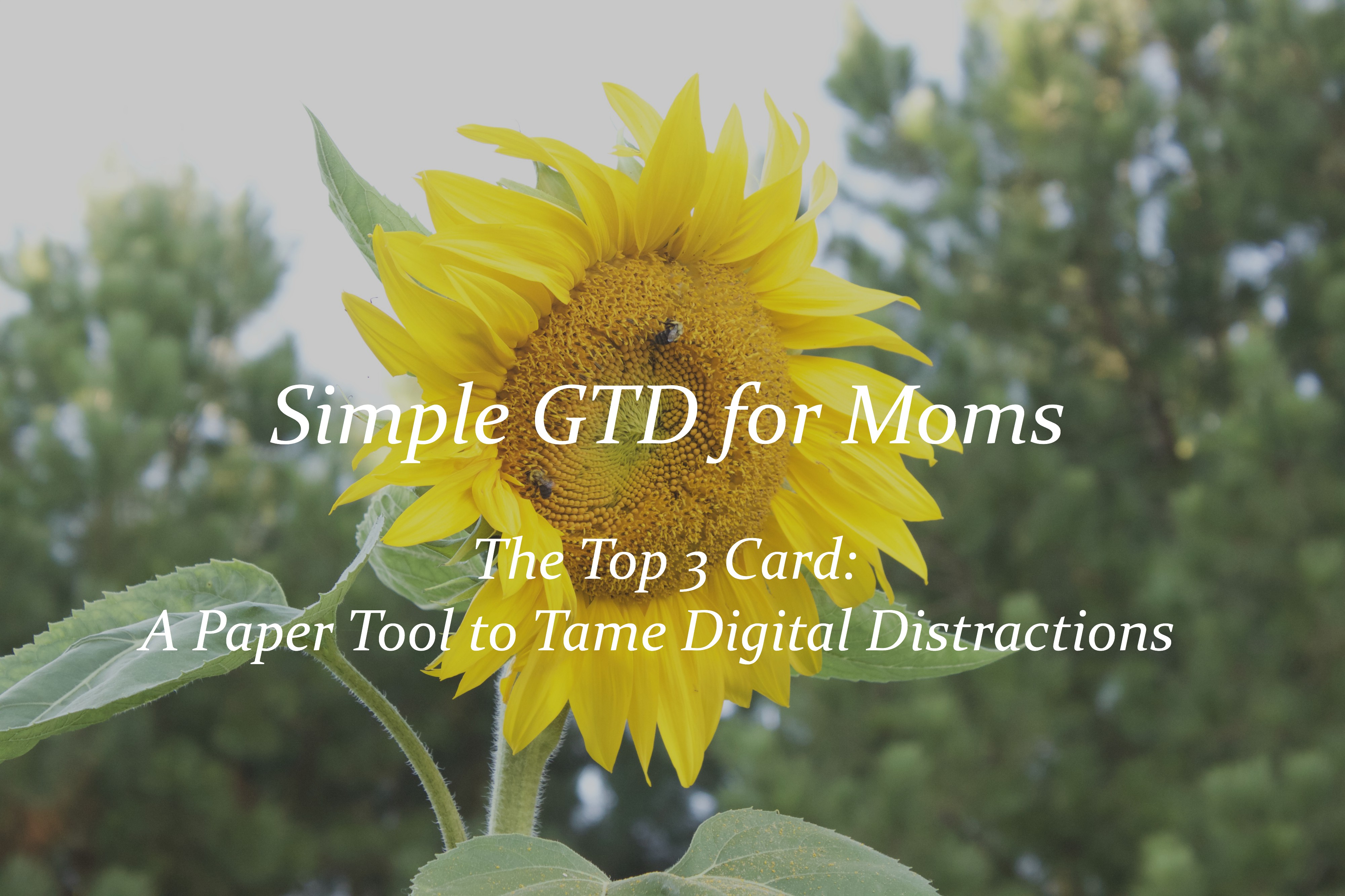Hopefully you have used the Simple GTD for Moms system to load almost all of your tasks and projects into your system – whether that’s on paper or on your phone. What do you do with them now? You can’t do all of these things at once and you likely can’t do them all today or even this week. So how do you decide what to do first?
This is the challenge that I faced with the Getting Things Done (GTD) system. I didn’t feel that there was a plan for deciding what to do or to encourage focus in my day. So today I’m going to write about a short routine that I use to keep my time and energy focused intentionally on the things that are important to me. Is it perfect? No. Do I EVER follow a rabbit trail on Facebook? Yes. But this system works for me because I can look back at my day and say with conviction that I moved the ball forward on at least 3 things that I truly feel God is calling me to do.
First let me encourage you to spend only 5-10 minutes on this process. Don’t overthink it and certainly don’t let it stress you out.
It will get easier if you do it each day. But if it takes you 30 minutes to do it, you won’t do it every day! So don’t get bogged down with the details or worrying if you’re “doing it right”.
Also remember that this is MY system, but YOUR system has to work for you. Make it your own. If you like to doodle or use colored pens to make it pretty, go for it. If you want to color code your tasks, try it and see what you think. (And definitely let me know how it went – color coding might help me too.)
I find it helpful to create my Top 3 Card early in the morning before my family is awake. And lately I have also experimented with making it at night before I go to bed. Choose a time when you can think and focus for a short amount of time.
The key concept here is just to spend a few minutes each day making a plan that is clear and that you can refer to often – without picking up your phone.
I use an index card and draw a vertical line down the middle of the lined side to divide it.
The left side is for tasks.

-
Write down the few things that come to mind that you know you want to or should do today. If it’s just part of your routine and you don’t really need a reminder to do it, there’s no need to write it. If you always exercise on Tuesdays and you don’t feel like it needs to be on your list, don’t add it.
- Go through all of your action items, one context at a time, and add 1-2 items from each that you’d like to do today. For some contexts, you might not need or want to do anything today. Or perhaps this is a busy day and you know your schedule is packed already so you’ll only have time to do a couple of items from your Phone Calls list and maybe something from Computer. Don’t overload your list. But you should at least read through each context’s list each day to make sure you’re not missing anything important.
- Once you run out of lines, STOP. If you finish ALL of these tasks today, you should first break out some wine and chocolate. Then go back to your contexts and pull more. This has never happened to me.
- Prioritize your tasks. There’s no need to overthink this – especially at first – and there is no one perfect way to do it. If you have thought about your priorities and have a framework for that, then use it. If not, now is not the time! Just assign your items an A, B,or C priority based on gut check and move on (Hint: Every task is NOT an A. You should have some B’s and C’s in there too.). Later, check out my next post on prioritization and/or the book Living Forward when you are ready to spend some more time on prioritizing.
- Sequence your tasks based on priority. Give each task a number, starting with 1, and continue until they all have an assigned number.
The right side is for your plan.

- Write in the hours that are your busiest. I list from 7AM – 5PM or I do sometimes use 4×6 index cards so that I can list 7AM-8PM. But for now, just use a card or piece of paper that you have.
- Write in the times that you have scheduled or routine events. If you have to attend a meeting, take or pick up kids from practice, go to a game, exercise at a specific time, go to an appointment, whatever, block it off. If you homeschool or have work hours, set aside time for this and block it off.
- With the time that’s left, slot in groups of tasks from the left side starting with the highest priority. You’re creating focus blocks. For example, I try to schedule at least an hour a day of writing time. I also set aside 30 minutes of time to do house cleaning and 30-45 minutes for email/computer work.
- Don’t forget to schedule in a break or two. I personally need to work on this one, but this is important. Moms don’t always get a lunch break, but at least try to take 15-20 minutes in your day to do something that is refreshing to you. Make a cup of tea and sit down with a book, call a friend, take a power nap, or go for a walk just to enjoy the sunshine – whatever you will look forward to and will refill your pitcher a bit. Schedule that too.
The front, unlined side is for your Top 3 Tasks.
Finally, take your first 3 tasks – the ones you numbered 1 to 3. Flip your card over and write your Top 3 tasks on the blank side. These are your highest priority tasks. Make sure you have the time set aside to do them. If you don’t, move your schedule around or cancel something. You want to give yourself the best chance of going to bed tonight knowing that you tackled these Top 3.
Give yourself some grace and know that you will not likely complete all of the tasks on your plan today. That’s ok. Because you’ve taken a few minutes to plan your day and make time for the most important things, you have increased the odds that you’ll actually do them first. We always have time for what we do first.
Now work your plan.
When at all possible, follow the schedule that you have set. Treat your appointments with yourself as you would treat a doctor’s appointment or a date with a friend. When life happens and a loved one needs you, do the thing that God has put in front of you right now. Then just pick up where you left off.
The beauty of using a simple index card is that it can sit out on your kitchen counter or you can carry it with you in your pocket. It’s more portable than a notebook and more durable and useful than a post-it note.
When you have an unexpected windfall of time – a meeting gets cancelled or you have extra time between appointments – take a look at your plan and see if there is something you can do in that time. Or just sit down with a cup of tea.
Or don’t work your plan.
This goes back to my last post and to this idea:
You can only feel good about what you’re not doing when you know everything you’re not doing. – David Allen in Getting Things Done
If I have a clear plan for what I WAS going to do today, then I can quickly evaluate whether the new thing that has come to my attention is more or less important and I can be confident in my decision to focus on one and not the other.
Now that you have a plan, you can be free to ignore it when presented with an opportunity that is more important to you. Your mind will be free, knowing that the world will not end, that you’re not “missing” anything, and that your plan will be waiting for you tomorrow.
If you try it, let me know!
I’d really love to see your comments on this post and hear what you honestly think. If you try it, let me know how it works – or doesn’t work – for you. Let me know how you change it to make it work better for you. If you already have a system that is working, please share what you do.
It’s easy to let the unimportant take up too much of the time that we have been given to steward. As moms at home we have the privilege and responsibility of managing our own time and that can be difficult sometimes – especially with so many digital distractions calling for our attention. So let’s share our thoughts and encourage each other with what has worked for us.
I pray that this is helpful to you and that a few minutes of using such a simple tool in planning your day will pay off in dividends of time well-spent later. Next week I’ll write more about prioritization and some methods you can use to discern your Top 3.






